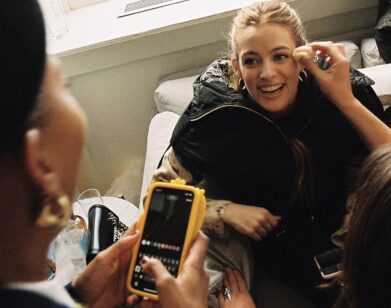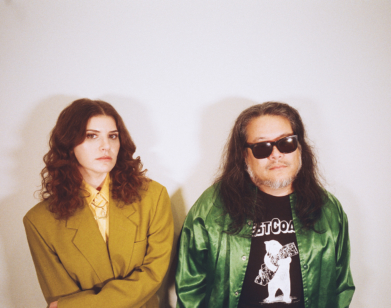Five things you might not know about Stevie Nicks

Despite spending 4o years in the world of showbiz, Stevie Nicks remains “the fairy godmother of rock ‘n’ roll,” according to many including rock biographer extraordinaire Stephen Davis. With her willowy black chiffon and undying love for top hats, this is a suiting moniker for the woman who transformed Fleetwood Mac and carved out a healthy solo career of her own. Approaching 70, Nicks shows no signs of slowing down with a Fleetwood Mac reunion tour kicking off in 2018. She’s the subject for his latest book Gold Dust Woman.
Davis has more than a dozen rock biographies under his belt, covering a multitude of great musicians from Led Zeppelin to Bob Marley. Years ago, Davis realized that no one was exploring the lives of these rock legends, so he did. Among the reasons why he chose Nicks as his next target of fascination, Davis noticed at one of her concerts that there were three generations of fans swept up by her music. Not only her original fans, now mostly in their sixties, and their children, in their thirties, made up the crowd, but their grandchildren as well. The Queen of Rock ‘n’ Roll is still cited as the inspiration for the current generation of female stars—Taylor Swift, Carrie Underwood and Florence Welch—thus earning her nickname.
In his biography, Davis combs through Nicks’ long career in great detail and explores why she remains such a force today. He reveals to Interview some of the most enlightening tidbits about Nicks’ life that he learned over the course of his research.
STEVIE’S WELSH ROOTS
STEPHEN DAVIS: I was talking to a musician a few years ago, and he pointed out to me that rock ‘n’ roll was invented in the American mid-South—Tennessee, Mississippi, Louisiana. All of these people were basically Welsh. Elvis Presley. That’s a Welsh name. Jerry Lee Lewis. Carl Perkins. I have this whole litany in the book of all of these people who invented this music and were basically of Welsh ancestry. Then Stevie Nicks came along in 1975 and started singing about Rhiannon, who was a Welsh goddess. Something clicked, like a Led Zeppelin moment. I think I began to identify with Stevie Nicks beyond the music itself, like the way people relate to Led Zeppelin. It’s beyond just the music. There’s this mystical plane about them. Stevie Nicks is the only artist I can think of in that rock movement that has that same kind of relationship with her audience. It’s that radiance. It’s amazing the charisma that she has. She has something else, whether it’s being in the Welsh Bardic tradition or personal magnetism. I don’t think anyone had pointed out [her Welsh background]. It’s an interesting idea, and I ran with it. It worked for me. I convinced myself.
HER QUIET EARLY YEARS
DAVIS: She was a very sheltered child. Her mother, Barbara Nicks, kept Stevie at home. She signed Stevie up for a lot of class, like tap dancing, plays and drama, but when it was over, Stevie Nicks went home. She always had a circle of best friends. She didn’t have a steady boyfriend until she met Lindsey Buckingham. She says today that she still spends a lot of time alone. She does her best writing when she’s alone and she’s sort of used to it. It’s a typical writer or artist’s upbringing, but surprising in the context of someone who became a rock star.
BORROWING THE HEARTBREAKERS
DAVIS: My favorite story of her and [Tom] Petty is when she started her solo career. She didn’t have a band, she didn’t have a single and she didn’t have anyone to produce her record. She basically stole the Heartbreakers from Tom Petty, stole his producer Jimmy Iovine and then stole their next single, which was “Stop Draggin’ My Heart Around.” She got everything she wanted. How did she do that? Petty was married to someone, and she was in a relationship, but somehow she got Tom Petty to give him her band, her next single and his producer. Subsequently when that single, “Stop Draggin’ My Heart Around,” came out, it coincided with the beginning of MTV. It’s hard to explain to someone today who wasn’t there how huge MTV was. Before MTV you had to go see your favorite band to just see what they looked like. Now they were on television all of the time, and people became addicted to it very quickly. But in the early days of MTV, they didn’t have many videos. People weren’t doing them. The only video they had was “Stop Draggin’ My Heart Around” with Stevie and Tom Petty, so they played it every hour for two years. This is really one of the ways that her solo career took off.
MATTERS OF STEVIE’S HEART
DAVIS: Lindsey Buckingham was her first steady boyfriend, and they moved in together. She waited tables and cleaned houses while he was working on their music. Eventually, Lindsey would work in the studio and that was that. “I’m only in this band because my boyfriend wouldn’t go off without me.” That’s been a trope in her life. A year later, she dumped him when they were making Rumors, but they both stayed in Fleetwood Mac. For the next 40 years, Lindsey was contractually obligated to produce Stevie’s songs and make her look good, and he did! He was very bitter about it. If anything makes the pages of Gold Dust Woman turn, it’s this 40-year dilemma of his, because he wasn’t happy about it. He would be mean to her, and she would be miserable. I can tell you that the tension between them is still going on. It’s probably the reason there hasn’t been a Fleetwood Mac album in 10 years, because I don’t think anyone is ready to see these people and try to work together again.
I think she’s still in love with him [Buckingham]. She knows there are people that are interested in the love story between Stevie and Lindsey, and that’s part of her thing. I think she has wished for decades that he could get over it.
That’s relationship no. 1, and then she had her relationships with most of the Eagles. She says the one that got away was Joe Walsh, who was the guitarist for the Eagles, and she fell in love with him. Their relationship became very destructive because of drugs, and he left her. “One of us is going to die,” he said, ”I don’t want it to be you.” She has said for years that he was The One. She’s always said that she couldn’t be married, because she has to fly off at a moment’s notice and go to Australia and stuff like that. She said that Joe Walsh was the one guy she would have changed that lifestyle for.
STEVIE WAS SILENCED UNTIL HER SOLO CAREER.
DAVIS: They didn’t really let her give interviews until she went out on her own and started giving interviews to promote her solo albums. We, as journalists, had never really heard from her, because she would apparently complain about this stuff to the press, and also was too stoned to give coherent interviews also. There’s a couple of filmed interviews of her from the late ‘70s or 1980 where she’s completely zonked and totally incoherent. They have to stop the interview. I’ve seen these tapes—they’re not on YouTube, thank God for her. It wasn’t until she went on her own that she spoken on her own behalf. For the next 30 years, she gave great, informative, very open interviews. Thank God, because a lot of that is in this book.
What I sort of took away from researching this book was Stevie was this young woman with a sheltered childhood, a lot of talent and incredible ambition. To achieve her goals, she had to hook up with an equally talented guy, who was also very ambitious, but was very domineering and controlling. He is indeed responsible for her launch into the public. Then she grew out of it, ditched the domineering, controlling boyfriend and became a bigger star than any of them. That’s what this book is all about to me. Through incredible ambition and a steely determination, she got what she wanted, which was major stardom at the top of her profession, where she still is.
STEPHEN DAVIS’ GOLD DUST WOMAN IS EXPECTED ON SHELVES NOVEMBER 21.




